Bumper Citroen C4 PICASSO 2016 2.G Owner's Manual
[x] Cancel search | Manufacturer: CITROEN, Model Year: 2016, Model line: C4 PICASSO, Model: Citroen C4 PICASSO 2016 2.GPages: 527, PDF Size: 13.72 MB
Page 70 of 527
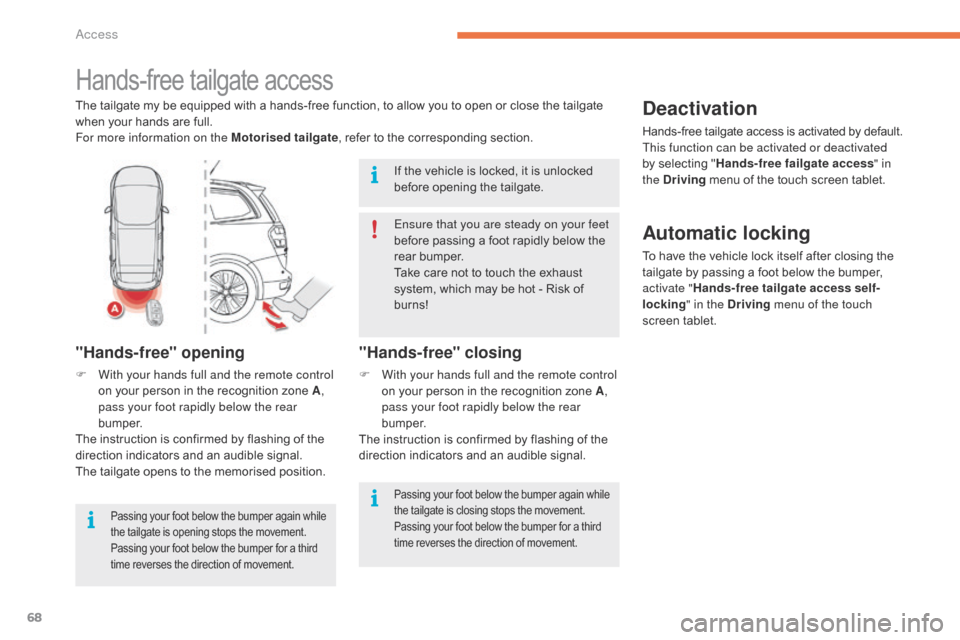
68
C4-Picasso-II_en_Chap02_ouvertures_ed01-2016
Hands-free tailgate access
The tailgate my be equipped with a hands-free function, to allow you to open or close the tailgate when your hands are full.
For more information on the Motorised tailgate ,
refer to the corresponding section.
"Hands-free" opening
F With your hands full and the remote control on your person in the recognition zone A,
pass your foot rapidly below the rear
b u m p e r.
The
instruction is confirmed by flashing of the
d
irection indicators and an audible signal.
The
tailgate opens to the memorised position.
Passing your foot below the bumper again while the tailgate is opening stops the movement. P
assing your foot below the bumper for a third
t
ime reverses the direction of movement.
"Hands-free" closing
F With your hands full and the remote control on your person in the recognition zone A,
pass your foot rapidly below the rear
b u m p e r.
The
instruction is confirmed by flashing of the
d
irection indicators and an audible signal.
Deactivation
Hands-free tailgate access is activated by default.
T his function can be activated or deactivated
by
selecting "Hands-free failgate access " in
the Driving
menu of the touch screen tablet.
Ensure that you are steady on your feet
before
passing
a
foot
rapidly
below
the
r
ear
bumper.
Take
care
not
to
touch
the
exhaust
s
ystem,
which
may
be
hot
-
Risk
of
b
urns!
If
the
vehicle
is
locked,
it
is
unlocked
b
efore
opening
the
tailgate.
Automatic locking
To have the vehicle lock itself after closing the t ailgate by passing a foot below the bumper,
a
ctivate " Hands-free tailgate access self-
locking " in the Driving menu of the touch
screen
t
ablet.
Passing your foot below the bumper again while the tailgate is closing stops the movement. P
assing your foot below the bumper for a third
t
ime reverses the direction of movement.
Access
Page 71 of 527

69
C4-Picasso-II_en_Chap02_ouvertures_ed01-2016
Operating faults
If several foot movements below the rear
bumper fail to open the tailgate, wait a
f
ew seconds before starting again.
The function is automatically deactivated in the
event
of heavy rain or accumulation of snow.
If
the function fails to operate, check
t
hat the electronic key is not exposed to
s
trong electromagnetic inter ference (a
s
mar tphone, ...).
The
function may not work correctly with a
pro
sthetic
le
g.
The
function may not work correctly if your
v
ehicle is fitted with a towbar. In
some circumstances, the tailgate may only o
pen or close, particularly if:
-
y
our vehicle is fitted with a towbar,
-
y
ou hitch or unhitch a trailer,
-
y
ou fit or remove a bicycle carrier,
-
y
ou load or unload bicycles from a bicycle
c a r r i e r,
-
y
ou place or lift something behind the
v
ehicle,
-
an
animal approaches the bumper,
-
y
ou are washing your vehicle,
-
a
service is being carried out on your
v
ehicle,
-
y
ou are accessing the spare wheel
(
depending
o
n
v
ersion).
To
avoid such operating problems, keep the
e
lectronic key away from the recognition zone
o
r deactivate "Hands-Free Tailgate Access".
Ensure
that no object or person might prevent
t
he correct opening or closing of the tailgate.
Be particularly aware of children when
operating
the tailgate.
2
Access
Page 168 of 527
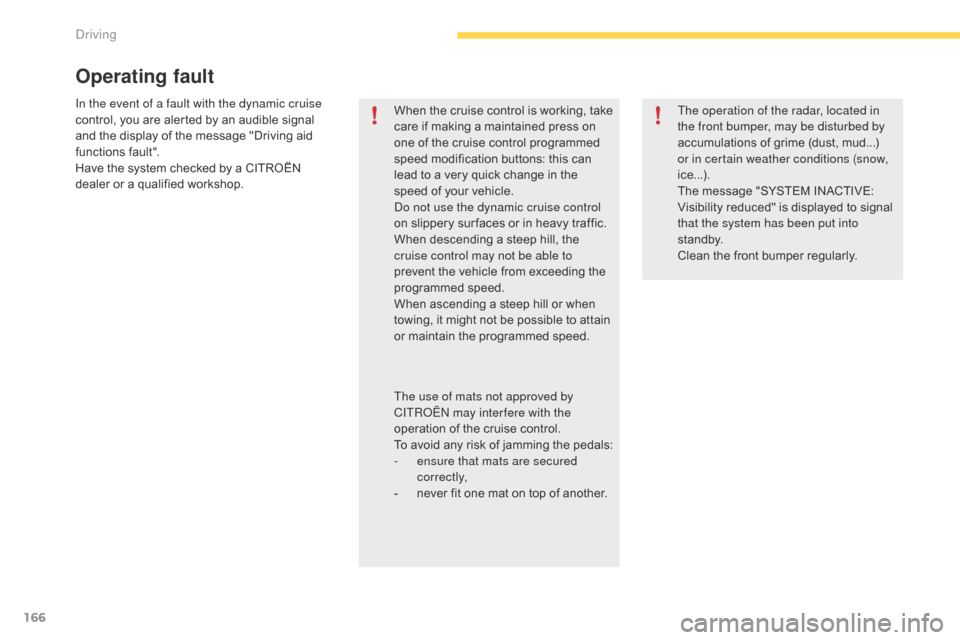
166
C4-Picasso-II_en_Chap04_conduite_ed01-2016
In the event of a fault with the dynamic cruise
control, you are alerted by an audible signal
a
nd the display of the message "Driving aid
f
unctions
f
ault".
Have
the system checked by a CITROËN
d
ealer or a qualified workshop. When
the cruise control is working, take
c
are if making a maintained press on
o
ne of the cruise control programmed
s
peed modification buttons: this can
l
ead to a very quick change in the
s
peed of your vehicle.
Do not use the dynamic cruise control
on
slippery sur faces or in heavy traffic.
When
descending a steep hill, the
c
ruise control may not be able to
prevent
the vehicle from exceeding the
pro
grammed
s
peed.
When
ascending a steep hill or when
t
owing, it might not be possible to attain
o
r maintain the programmed speed.
Operating fault
The operation of the radar, located in
the front bumper, may be disturbed by
accumulations of grime (dust, mud...)
o
r in certain weather conditions (snow,
ice...).
The
message "SYSTEM INACTIVE:
V
isibility reduced" is displayed to signal
t
hat the system has been put into
st a n dby.
Clean
the front bumper regularly.
The use of mats not approved by
CITROËN may inter fere with the
operation
of
the
cruise
control.
To
avoid
any
risk
of
jamming
the
pedals:
-
e
nsure that mats are secured
c o r r e c t l y,
-
n
ever
fit
one
mat
on
top
of
another.
Driving
Page 169 of 527

167
C4-Picasso-II_en_Chap04_conduite_ed01-2016
Dynamic cruise control with Stop function
The dynamic cruise control is a driving aid that cannot in any circumstances
replace the observation of speed limits
and safe distances, nor the need for
vigilance
on the part of the driver.
It
i
s
r
ecommended that
y
ou always
k
eep
y
our feet close to the pedals.
The
driver must be ready to take back
c
ontrol of their vehicle at any time,
using
the brake or accelerator pedal as
a
ppropriate.
This
system
assures
two
functions:
-
a
utomatic
regulation
of
the
speed
of
the
v
ehicle
to
a
value
programmed
by
the
d
river,
-
a
utomatic
adjustment
of
the
distance
b
etween your vehicle and the vehicle
ahead.
It
manages
the
acceleration
and
deceleration
o
f
the
vehicle
by
automatically
acting
on
the
e
ngine
and
the
braking
system.
To do this, the system has a radar, located in
the
middle
of
the
front
bumper,
with
a
maximum
r
ange
of
150
metres.
Principles
This system detects a vehicle running in front of y our vehicle, travelling in the same direction.
It automatically adapts the speed of your
vehicle to that of the vehicle in front, to maintain
a
constant distance.
If
the vehicle in front is running more slowly, the
s
ystem slows, or even stops your vehicle, using
e
ngine braking and the braking system.
If
the braking system is used to decelerate the
v
ehicle, the brake lamps come on.
If
the vehicle in front accelerates or changes
l
ane, the cruise control progressively
a
ccelerates your vehicle to return to the
programmed
s
peed.
If the driver operates a direction indicator to
overtake
a slower vehicle, the dynamic cruise
c
ontrol allows your vehicle to temporarily
approach the vehicle in front to assist the
overtaking
ma
noeuvre,
t
hough
n
ever
e
xceeding
t
he programmed speed.
4
Driving
Page 177 of 527
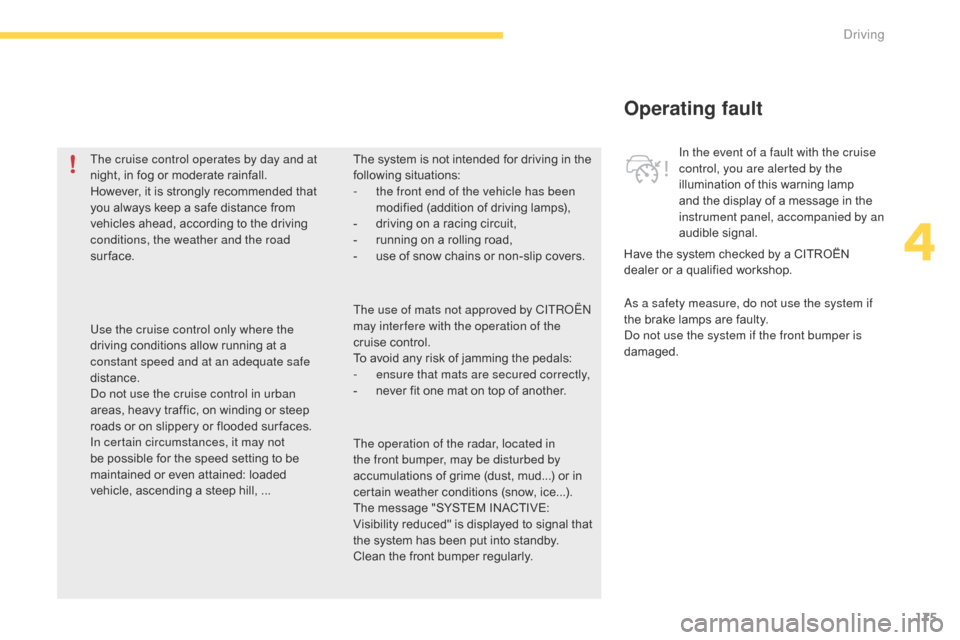
175
C4-Picasso-II_en_Chap04_conduite_ed01-2016
Operating fault
As a safety measure, do not use the system if
the brake lamps are faulty.
Do not use the system if the front bumper is
damaged. In the event of a fault with the cruise
control, you are alerted by the
illumination
of this warning lamp
a
nd the display of a message in the
in
strument panel, accompanied by an
audible
s
ignal.
The cruise control operates by day and at
night,
in
fog
or
moderate
rainfall.
However,
it
is
strongly
recommended
that
y
ou
always
keep
a
safe
distance
from
v
ehicles
ahead,
according
to
the
driving
c
onditions, the weather and the road
sur face.
Use the cruise control only where the
driving
conditions
allow
running
at
a
c
onstant speed and at an adequate safe
distance.
Do not use the cruise control in urban
areas,
heavy
traffic,
on
winding
or
steep
r
oads
or
on
slippery
or
flooded
sur faces.
In certain circumstances, it may not
be
possible
for
the
speed
setting
to
be
m
aintained
or
even
attained:
loaded
v
ehicle,
ascending
a
steep
hill,
... The
system
is
not
intended
for
driving
in
the
fo
llowing
s
ituations:
-
t
he front end of the vehicle has been
modified
(addition
of
driving
lamps),
-
d
riving
on
a
racing
circuit,
-
r
unning
on
a
rolling
road,
-
u
se
of
snow
chains
or
non-slip
covers.
Have the system checked by a CITROËN
d
ealer or a qualified workshop.
The operation of the radar, located in
the front bumper, may be disturbed by
accumulations
of
grime
(dust,
mud...)
or
in
c
ertain
weather
conditions
(snow,
ice...).
The
message
"SYSTEM
INACTIVE:
V
isibility
reduced"
is
displayed
to
signal
that
t
he
system
has
been
put
into
standby.
Clean
the
front
bumper
regularly.
The use of mats not approved by CITROËN
may inter fere with the operation of the
cruise
control.
To
avoid
any
risk
of
jamming
the
pedals:
-
e
nsure that mats are secured correctly,
-
n
ever
fit
one
mat
on
top
of
another.
4
Driving
Page 179 of 527
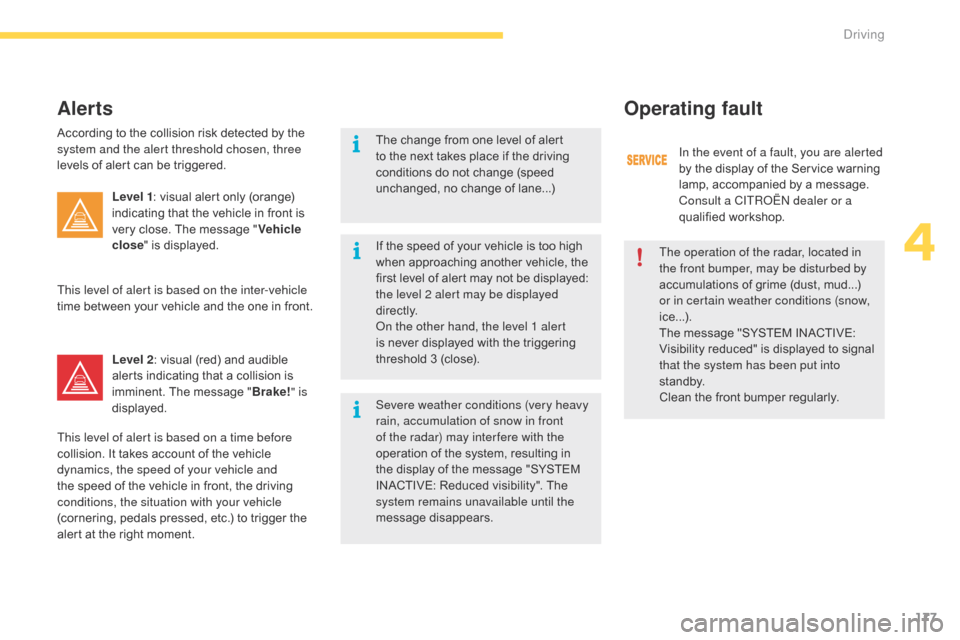
177
C4-Picasso-II_en_Chap04_conduite_ed01-2016
The change from one level of alert to the next takes place if the driving
c
onditions do not change (speed
u
nchanged, no change of lane...)
Severe weather conditions (very heavy
rain, accumulation of snow in front
of the radar) may inter fere with the
operation
of the system, resulting in
t
he display of the message "SYSTEM
I
NACTIVE: Reduced visibility". The
s
ystem remains unavailable until the
message
d
isappears.
If
the speed of your vehicle is too high
w
hen approaching another vehicle, the
f
irst level of alert may not be displayed:
t
he level 2 alert may be displayed
di r e c t l y.
On the other hand, the level 1 alert
is
never displayed with the triggering
t
hreshold 3 (close).
Alerts
According to the collision risk detected by the system and the alert threshold chosen, three
levels
of alert can be triggered.
Level 1 :
visual alert only (orange)
i
ndicating that the vehicle in front is
v
ery close. The message "Vehicle
close "
is displayed.
Level 2 :
visual (red) and audible
a
lerts indicating that a collision is
i
mminent. The message "Brake! " is
displayed.
This level of alert is based on the inter-vehicle
time
between your vehicle and the one in front.
This level of alert is based on a time before
collision.
It takes account of the vehicle
d
ynamics, the speed of your vehicle and
the
speed of the vehicle in front, the driving
c
onditions, the situation with your vehicle
(cornering,
pedals pressed, etc.) to trigger the
a
lert at the right moment.
Operating fault
In the event of a fault, you are alerted
by the display of the Service warning
l
amp, accompanied by a message.
Consult a CITROËN dealer or a
qualified
w
orkshop.
The operation of the radar, located in
the front bumper, may be disturbed by
accumulations
of grime (dust, mud...)
o
r in certain weather conditions (snow,
ice...).
The
message "SYSTEM INACTIVE:
V
isibility reduced" is displayed to signal
t
hat the system has been put into
st a n dby.
Clean
the front bumper regularly.
4
Driving
Page 184 of 527
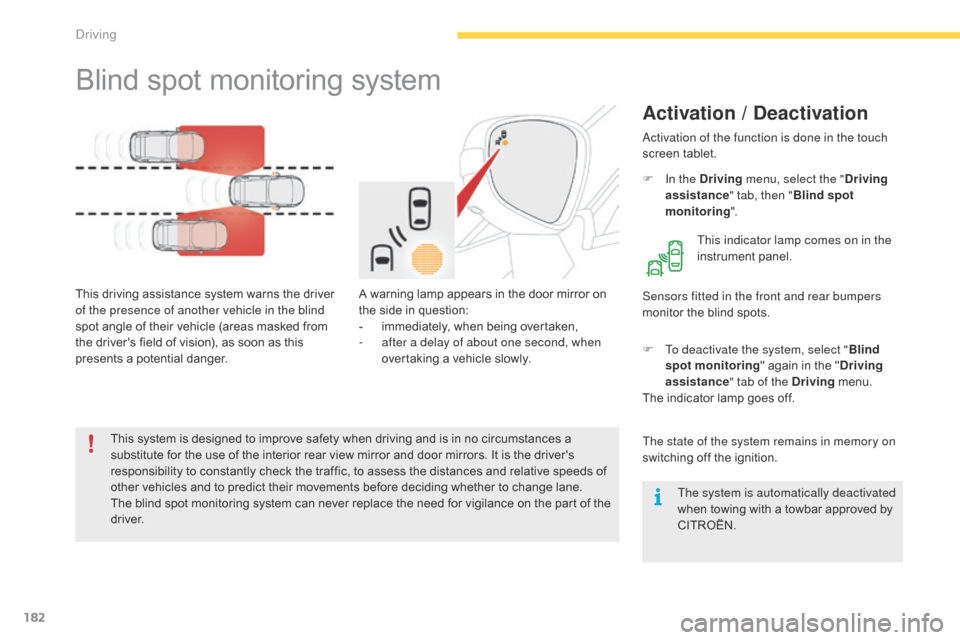
182
C4-Picasso-II_en_Chap04_conduite_ed01-2016
Blind spot monitoring system
Activation / Deactivation
A warning lamp appears in the door mirror on the side in question:
-
i
mmediately, when being overtaken,
-
a
fter a delay of about one second, when
overtaking
a vehicle slowly.
This
driving
assistance
system
warns
the
driver
o
f the presence of another vehicle in the blind
spot
angle
of
their
vehicle
(areas
masked
from
t
he
driver's
field
of
vision),
as
soon
as
this
p
resents
a
potential
danger. Sensors fitted in the front and rear bumpers
monitor
the blind spots.
This
system
is
designed
to
improve
safety
when driving and is in no circumstances a
s
ubstitute
for
the
use
of
the
interior
rear
view
mirror and door mirrors. It is the driver's
r
esponsibility
to
constantly
check
the
traffic,
to assess the distances and relative speeds of
o
ther
vehicles
and
to
predict
their
movements before deciding whether to change lane.
The
blind
spot
monitoring
system
can
never
replace the need for vigilance on the part of the
d
river. Activation of the function is done in the touch
screen
t
ablet.
F
I
n the Driving
menu, select the " Driving
assistance " tab, then "Blind spot
monitoring ".
This indicator lamp comes on in the
instrument
pan
el.
The state of the system remains in memory on
switching off the ignition.
F
T
o deactivate the system, select "Blind
spot monitoring "
again in the "Driving
assistance " tab of the Driving
menu.
The
indicator lamp goes off.
The system is automatically deactivated
when
towing with a towbar approved by
CIT
ROËN.
Driving
Page 186 of 527
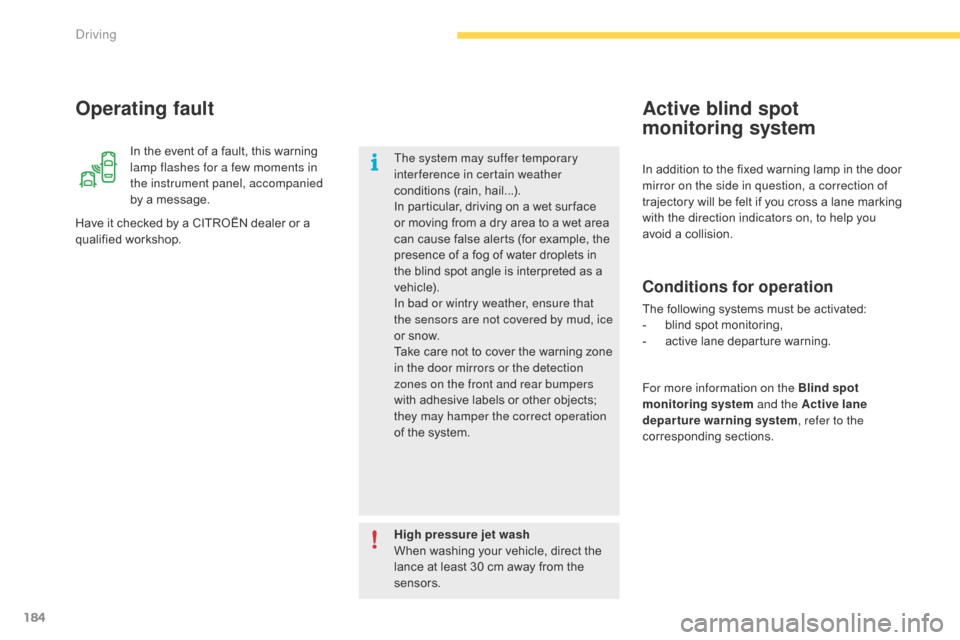
184
C4-Picasso-II_en_Chap04_conduite_ed01-2016
In the event of a fault, this warning lamp flashes for a few moments in
the instrument panel, accompanied
by
a message.
Operating fault
Have it checked by a CITROËN dealer or a qualified w orkshop. The system may suffer temporary
interference in certain weather
conditions
(rain, hail...).
In particular, driving on a wet sur face o
r moving from a dry area to a wet area c
an cause false alerts (for example, the
p
resence of a fog of water droplets in
t
he blind spot angle is interpreted as a
v
ehicle).
In bad or wintry weather, ensure that
the sensors are not covered by mud, ice
or
snow.
Take
care not to cover the warning zone
i
n the door mirrors or the detection
zones on the front and rear bumpers
with
adhesive labels or other objects;
t
hey may hamper the correct operation
of
the system.
High pressure jet wash
When
washing your vehicle, direct the
l
ance at least 30 cm away from the
sen
sors.In
addition to the fixed warning lamp in the door
m
irror on the side in question, a correction of
trajectory will be felt if you cross a lane marking w
ith the direction indicators on, to help you
avoid a collision.
Conditions for operation
The following systems must be activated:
- b lind spot monitoring,
-
a
ctive lane departure warning.
Active blind spot
monitoring system
For more information on the Blind spot
monitoring system and the Active lane
departure warning system , refer to the
corresponding
s
ections.
Driving
Page 189 of 527

187
C4-Picasso-II_en_Chap04_conduite_ed01-2016
This system indicates the proximity of an obstacle (examples: pedestrian, vehicle, tree,
g
ate) which comes within the field of detection
o
f sensors located in the bumper.
Certain
types of obstacle (examples: stake,
r
oadworks cone) detected initially will no longer
b
e detected at the end of the manoeuvre, if
they
are located in blind spots in the sensors'
f
ield
o
f
d
etection.
Parking sensors
This system cannot in any
circumstances replace the need for
vigilance on the part of the driver.The
system is switched on by engaging reverse
g
e a r.
This is confirmed by an audible signal.
The system is switched off when you come out
of reverse gear.
Audible assistance
The proximity information is given by an i
ntermittent audible signal, the frequency of which i
ncreases as the vehicle approaches the obstacle.
The
sound emitted by the speaker (right or left)
i
ndicates the side on which the obstacle is located.
When the distance between the vehicle and
the
obstacle becomes less than approximately
t
hirty centimetres, the audible signal becomes
c
ontinuous.
Rear parking sensors
Visual assistance
This supplements the audible signal by d isplaying bars in the screen or the instrument
p
anel which move progressively nearer to
t
he vehicle. When the obstacle is near, the
"
Danger" symbol is displayed.
4
Driving
Page 191 of 527

189
C4-Picasso-II_en_Chap04_conduite_ed01-2016
Reversing camera
Clean the reversing camera regularly u
sing a soft, dry cloth.
The
reversing
camera
is
activated
automatically
w
hen
r
everse
g
ear
i
s
enga
ged.
Depending
on
version,
the
image
is
displayed
in
t
he
touch
screen
tablet
or
the
instrument
panel. The
superimposed
representation
of
guide
l
ines
helps
with
the
manoeuvre. The
blue lines represent the general direction
o
f the vehicle (the difference corresponds to
the
width of your vehicle without the mirrors).
The red lines represent a distance of about
30
cm
beyond the edge of your vehicle's rear
b
u m p e r.
The
green lines represent distances of about 1
a
nd
2
metres beyond the edge of your vehicle's
r
ear
bumper.
The turquoise blue curves represent the
maximum turning circle.
The
reversing
camera
cannot
in
any
c
ircumstances replace the need for
vigilance
on
the
part
of
the
driver. Opening
the tailgate causes the display
t
o disappear.
The
reversing
camera
function
may
be
c
ompleted
with
parking
sensors.
High pressure jet washing
When
washing
your
vehicle,
do
not
d
irect
the
lance
within
30
cm
of
the
c
amera
lens. They
are
represented
by
lines
marked
"
on
the
ground"
and
do
not
allow
the p
osition of the vehicle to be determined
relative
to
tall
obstacles
(for
example:
o
ther
vehicles,
...).
Some
d
eformation
o
f
t
he
i
mage
i
s
n
ormal.
It is normal to be able to see part of
the number plate at the bottom of the
screen.
4
Driving